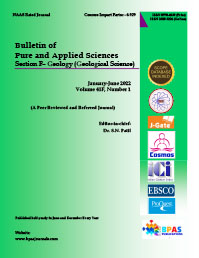Utilization of GIS Model Mapping to Detect Fault Segments in Mesopotamian Foredeep Basin
DOI:
https://doi.org/10.48165/bpas.2023.42F.2.5Keywords:
Drainage pattern, Fault lines, GIS Model, Lineament, Lithological contactAbstract
The Mesopotamia Basin is widely recognized as a significant aggradation geomorphological entity, characterized by the dominance of fluvial, lacustrine, and aeolian landforms. The geographical scope of this study spans a specific region within the Mesopotamian Basin, specifically including Nasiriyah and Basrah located in the southern region of Iraq. It comprises a collection of Joint and fault systems that serve as indicators of various tectonic occurrences that have influenced the Arabian plate from the pre-Cambrian era up till the present day. The major goal of this model is to mapping and detects fault segments to get information about the large faults existing which is not recognized by prior work. A Geographic Information System (GIS) model was employed to create three digital layers, namely Lineament, drainage patterns, and lithological contact. These layers were established using several sources of information. The initial step of the GIS demonstration includes the input information, and the subsequent includes the selection of the equation for this model to specify the vulnerability of faulting segments in the research sector. Moderate to large lineaments (fault lines) were identified the results suggest an additional (26,15) new fault segment line numbers for the areas Nasiriyah and Basrah respectively which were not known by the fault map over the research sector, these fault lines reflect crustal structures (large length lineaments), as well as analysis lineaments from satellite images, enables obtaining a miscellany of terrain applications, such as the selection of landfill sites, determining terrain stability, dam sites, and many other applications
Downloads
References
Abdul- jabbar, A. (2013). Tectonic of Al Thirthar, Al- Habbaniya , and Al- Razzazah depressions, west of Tigris river, Iraq. ph. D thesis . Univer. Of Baghdad, collage of science, dep. Of geology. P. 130. Un published.
Ahmed, M and Al-Dousari, A. (2013). Geomorphological Characteristics of the Um-Rimam depression on northern Kuwait. Kuwait journal of science, 40, 165-178.
Al- Kadhmi, j, Sissakian, V, Fattah, S. and Deikran, D. (1996). Tectonic map of Iraq. State company of geological survey and mining, Baghdad.
Al-Saedi, Zeyad. J. (2020). Effect of fractures on Euphrates River in Mesopotamian basin in Iraq. Bulletin of pure and applied science. 169-181.
Al–Sakini, J. (1993). New looks on the history of old tigris and Euphrates rivers, in the light of geological evidences, recent archeological discovers and historical sources. Oil exploration co., Baghdad, Iraq, 93p.
**********
observed in the study area. These fault lines do not correspond to any fault lines depicted in the tectonic map utilized in the research framework. It is possible that these newly identified fault lines, as indicated by the model employed in this study, represent surface manifestations of previously unknown fault locations within the research sector. This suggests that the implementation of the applicable model proved to be successful in identifying linear characteristics, such as fault lines, within the specified regions of interest. The findings suggest the inclusion of additional fault segments, specifically (26, 15), in the fault line numbers for the regions of Nasiriyha and Basrah. These segments were not previously identified in the fault map used for the study area. From satellite images, enables obtaining a miscellany of terrain applications, such as the selection of landfill sites, dam sites, and many other applications, but the most effective are those related with water resources management.
Fouad, S. (2010). Tectonic and structural evolution of the Mesopotamian foredeep, Iraq. Iraqi bulletin of geology and mining. 6(2), 41-53.
Hassan, K and Galib, A. (2004). Detailed geological survey on lissan area Karbala Najaf plateau. GEOSERV, report no.2870.
L. Aller, Bennett, J.H. Lehr, and R.J. Petty. (1995). Drastic: a standard system for evaluating groundwater pollution potential using hydrogeological settings. Rep. epa/600/2 85/018 R.S., Kerr environmental research laboratory, environmental protection agency, Okla, USA.
Sarp, Gulcan. (2005). Lineament analysis from satellite images, north-west of Ankara. Ph.D. thesis. Middle East technical university. p 90.
Saud, M.A. (2008). Using ASTER images to analyze geologic linear features in wadiaurnah basin, Western Saudis Arabia: Open remote sensing journal.
Sissakian, V. and Saeed, Zahra. (2012). Lithological map of Iraq, compiled using GIS techniques. Iraqi bulletin of geology and mining. 8(3), 29-50.
Downloads
Published
Issue
Section
License

This work is licensed under a Creative Commons Attribution-NonCommercial-NoDerivatives 4.0 International License.



